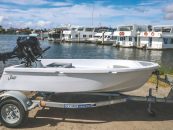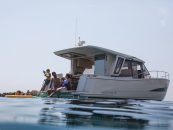The feeling becomes overwhelming as you climb over the last pinnacle of rock face to the views of swirling waters, birds diving, fish chopping the surface of the ocean as far as the eye can see, and the thought of knowing you are finally there.
Rock fishing has the title of claiming more lives than any other recreational sport around the country. For this alone, most anglers opt to fish the more accessible areas where the fish are hunted in more ways than one. Spear fishermen, professionals and every day anglers swarm to these more accessible spots. Over the years, the fish become hook shy and weary of anything that generally swims or is placed in front of them.
Scattered along the coastline from the Sunshine Coast south to northern New South Wales are a variety of rocky headlands with steep escarpments and good ledges. Most of the fishing activities around these areas are normally done where the beaches meet the rocks. But further around the face of rocks, virgin fishing grounds can be found. It is these holes and locations that the intrepid angler dreams of. During certain times of the year, anglers come out of the woodwork to fish for the different migrating species making their annual run along the coastline.
There can never be enough planning when it goes into these kinds of topics, and at the same time there can never be enough fish to catch. Headland fishing is exhilarating, mesmerising, and a total thrill. Just watching the fish chasing your lure back to the rocks with their mouths wide open chomping at every opportunity they get. Seeing the baitfish showering behind the break and watching the jewfish slap their tails along the ledges as mullet and other small fish school up in small crevices trying to escape the predators. Setting out live baits under balloons and watching mackerel or tuna, or even a marlin come up to gorge, and then swimming off at a fair rate of knots is something you can never get enough of. All of this is what waits for that intrepid angler as he climbs over the last rock face.
Knowing the areas you intend on fishing is an important part of the pre-planning stage. Tracks should be marked out. Of course, the easiest route should be taken. Having an escape plan, in case you do get washed off the rocks and into the water, is a necessity. Knowing which direction to swim can save your life.
Spanish mackerel, cobia, tailor, a variety of tuna species, drummer, black fish, groper, kingfish, and even marlin are all targeted from the ledges. To catch these fish, a fair amount of gear is required to tackle them.
Long gaffs to reach the water are essential. A combination of rods and reels, and various leaders lines, terminal tackle, somewhere to keep your bait alive, and not to forget a carry-bag to bring your fish home in is required. All of this has to be carried in along with some food, water, and more importantly the safety gear. Ropes, rock boots, a waterproof jacket and long pants, headlamp or torch, and a personal floatation device (PFD) just in case. Put all of this together and you have an arsenal of gear to take with you. The key to success here is to put a fine-tooth comb through everything; in the end, you should be left with a neat backpack, and your rods and gaff tied together.
This sounds like a lot of work, and indeed it is.
Tailor at Burleigh Headland
There are other easier ways to rockfish, and that is off our local headlands, such as Burleigh. Still, a lot of caution is required, as you do not want to stand on that slippery rock with barnacles glued to the edge. It does resemble a cheese grater. Believe me, your leg does come off second best. And do not forget those rocks that are seriously unbalanced.
There are quite a few factors to keep in mind. The Burleigh headland is one that many anglers fish, and timing is the key. For me and a few others, being down there when it is pitch black and walking around the front, knowing the rocks, knowing where to fish from, and what you are about to target are all extremely important. By sunrise, you should have a bag of fish, and be walking back out, often passing other anglers heading down for a fish, who unknowingly have already missed the bite.
Given the right conditions, it is an area that I teach my seven-year-old son to fish from. I feel learning to rock fish at an early age will give him plenty of experience as he gets older and understand the safety aspects of rock fishing.
Tailor is a species that schools during the cooler months of the year. However, they are also found here every day of the year, just not in larger numbers at times.
Gear selection is paramount. Keep the rod light, but have the length to get over the rocks. I use a Shimano Aerocast 11-footer, matched with a 14000LC Baitrunner. Even a Sustain 6000 would be good, spooled with 30lb power pro braid, and 4 feet of 30lb fluorocarbon leader. Arm yourself with a bunch of Raider 40 and 65gram lures. The locally made Lasers work well in 25gram white.
Work the wash and work the ledges, and remember you will come off second best against the rocks when your lures bite into one of the thousands of cunjevoi bulbs lining the outer rock ledge. There is nothing like fresh tailor for breakfast, and what a great way to start your day.
Good luck and enjoy!
By Paul Burt
Photo of Caelan, courtesy of Paul Burt



























